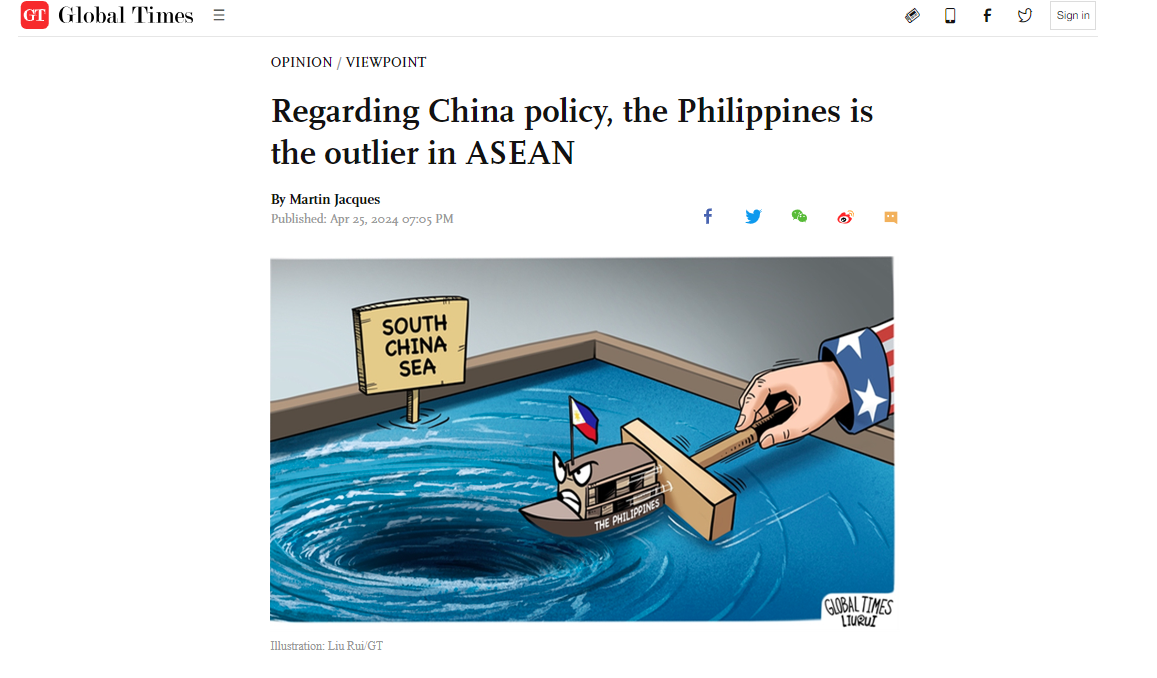LATEST INSIGHTS
Your Present Location: LATEST INSIGHTSMartin Jacques: Regarding China policy, the Philippines is the outlier in ASEAN
Source: Global Times Published: 2024-04-25

The shift in the attitude of the Philippine government toward the US and China should not come as a great surprise. The Philippines has long been closer to the US than any other ASEAN country. In 1951 it signed a defense treaty with the US, has been host to five US military bases, and the two militaries enjoy a very close relationship. The Philippine government's submission to the Hague tribunal on the South China Sea was a result of close collaboration with the US, which was, in effect, its joint author. However, the unexpected election of Rodrigo Duterte as Philippine president in 2016 changed the dynamic. Duterte refused to support the Hague judgment and instead expressed a desire to distance the Philippines from the US and strengthen ties with China, ultimately undermining the Hague judgment.
After his election as president in 2022, Ferdinand Marcos Jr. initially went through the motions of supporting Duterte's position, but since has engaged in a monumental volte-face. Behind the scenes the US had made a huge effort to secure the shift, which was hardly surprising given that Duterte's position had seriously undermined its policy in the region and weakened its alliance system. Marcos Jr. is the opposite, happy to do America's bidding and be a willing instrument of US policy. In two short years, the Philippines has become a proactive participant in America's military alliance system, agreed to host four new US military bases in addition to the existing five, participated in talks with the US and Japan in Washington earlier in April, and is pursuing an increasingly provocative position against China in the South China Sea.
Since its turn against China, the US has been highly active in seeking to reframe and extend its military alliances in East Asia. It talks of moving from the previous hub and spokes model to a lattice-like network involving closer cooperation between the various partners, as can be seen in the case of South Korea and Japan, with the latter increasingly seen by the US as its crucial partner in the region. This month and next sees the first-ever joint military exercises inside the Philippines's EEZ, involving the US, Australia and the Philippines as well as Japan as an observer, in what can only be regarded as a deliberately provocative act.
Meanwhile, Marcos Jr. has abandoned Duterte's status quo policy on its disputed claims with China in the South China Sea and made the BRP Sierra Madre, the rusting hulk on the submerged Ren'ai Jiao, also known as Second Thomas Shoal, which was deliberately sunk there in 1999, the central focus of its territorial claims. There have been clashes between Chinese coastguard ships and Filipino resupply vessels. There are signs that the Philippines is seeking to transform the reef by transporting construction materials to the site of the BRP Sierra Madre in violation of the previous understanding with China. And there are moves afoot to introduce domestic legislation designed to codify Filipino demands. The US has reaffirmed that Article IV of the 1951 US-Philippines Mutual Defense Treaty extends to armed attacks on Philippine armed forces, public vessels, or aircraft-including those of its Coast Guard-anywhere in the South China Sea.
The steadily deteriorating relationship between the US and China is liable to rear its head in any number of areas. The South China Sea is hardly a new subject in this context. But it now threatens to return with a new vengeance. The US is not a party to any of these disputes but, by explicitly extending the terms of the Mutual Defense Treaty with the Philippines to include the latter's territorial claims and BRP Sierra Madre, the US is showing a growing willingness to become directly involved in the territorial disputes in the South China Sea.
In contrast to Marcos Jr., the other nine members of ASEAN continue to enjoy a very positive and expanding relationship with China, including Vietnam, which has a contentious relationship with China regarding the South China Sea. Of the other claimants, Malaysia has become increasingly close to China. The Philippines is the outlier bar none in ASEAN. As we saw earlier, however, the Philippines has become increasingly divided over China. Duterte, who was a far more popular president than Marcos Jr. is, has clashed with Marcos Jr. over China. Meanwhile Duterte's daughter, Sara Duterte-Carpio, Marcos's vice president, is highly popular and will almost certainly stand in the next presidential election in 2028. She is already very much the front-runner and is politically close to her father.
Whatever the future may hold, we are in increasingly dangerous waters. Marcos Jr. is little more than a US puppet, willing, it would seem, to do whatever the US might propose. One of the most concerning aspects of this is the increasing involvement of the Philippines in America's military strategy toward Taiwan island. One of America's central concerns about Duterte was that, while he was president, the Philippines would resist being conscripted to its pro-Taiwan positions. That is no longer the case. On the contrary, the Philippines could agree to move closer to Taiwan island in the manner of the US' other allies.
The author is a visiting professor at the Institute of Modern International Relations at Tsinghua University and a senior fellow at the China Institute, Fudan University. Follow him on X @martjacques. opinion@globaltimes.com.cn























































































 京公网安备 11010802037854号
京公网安备 11010802037854号





